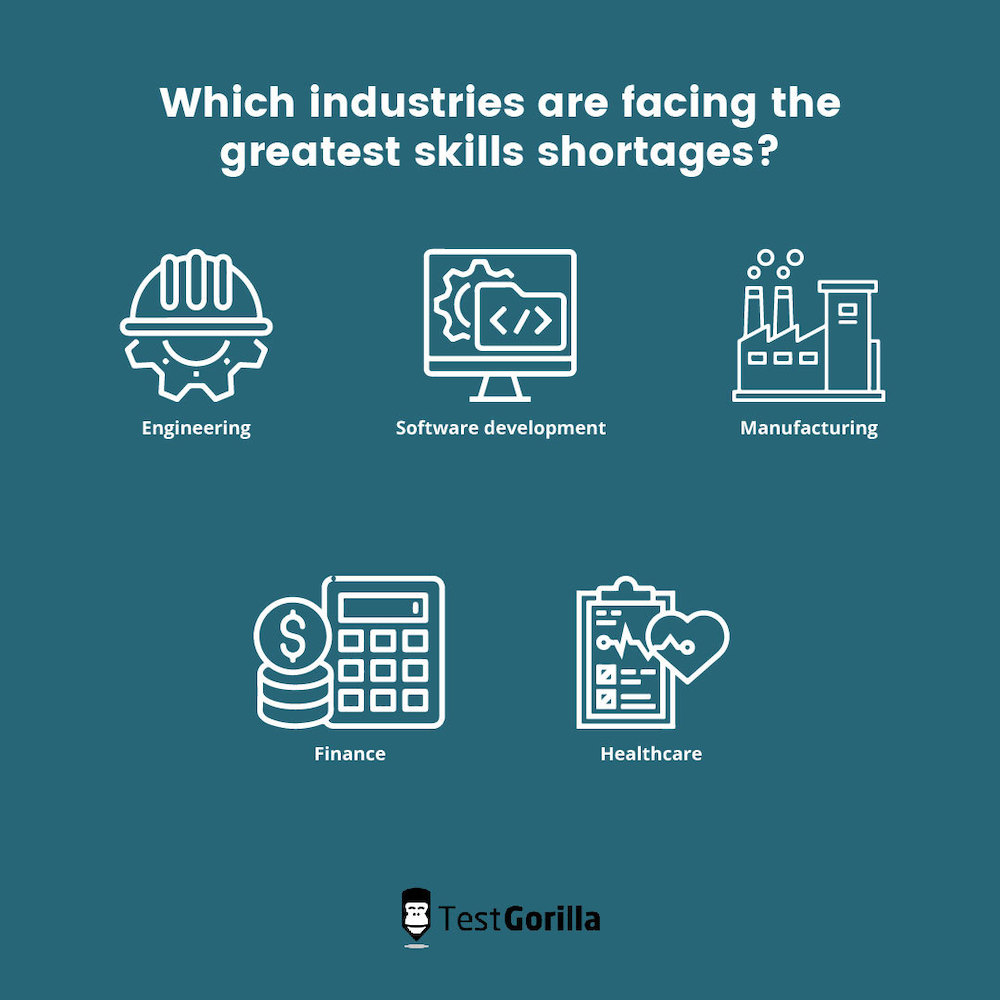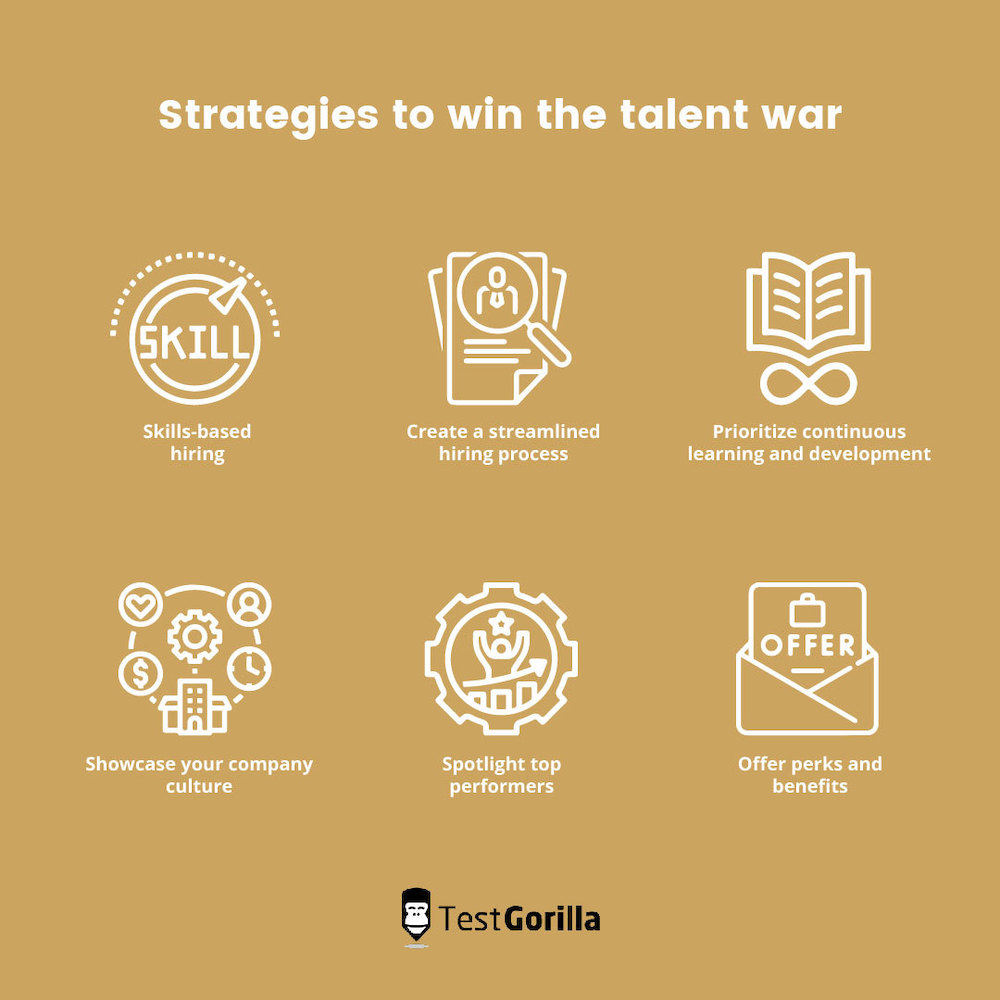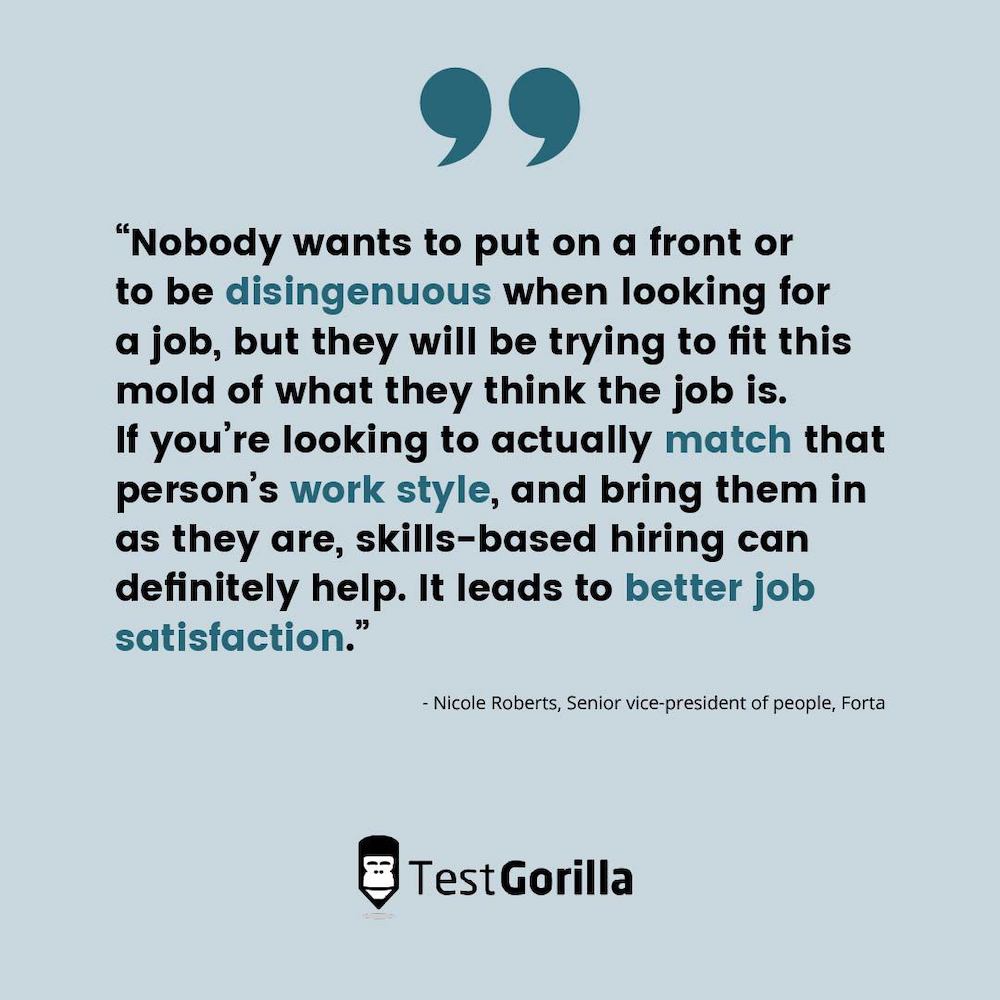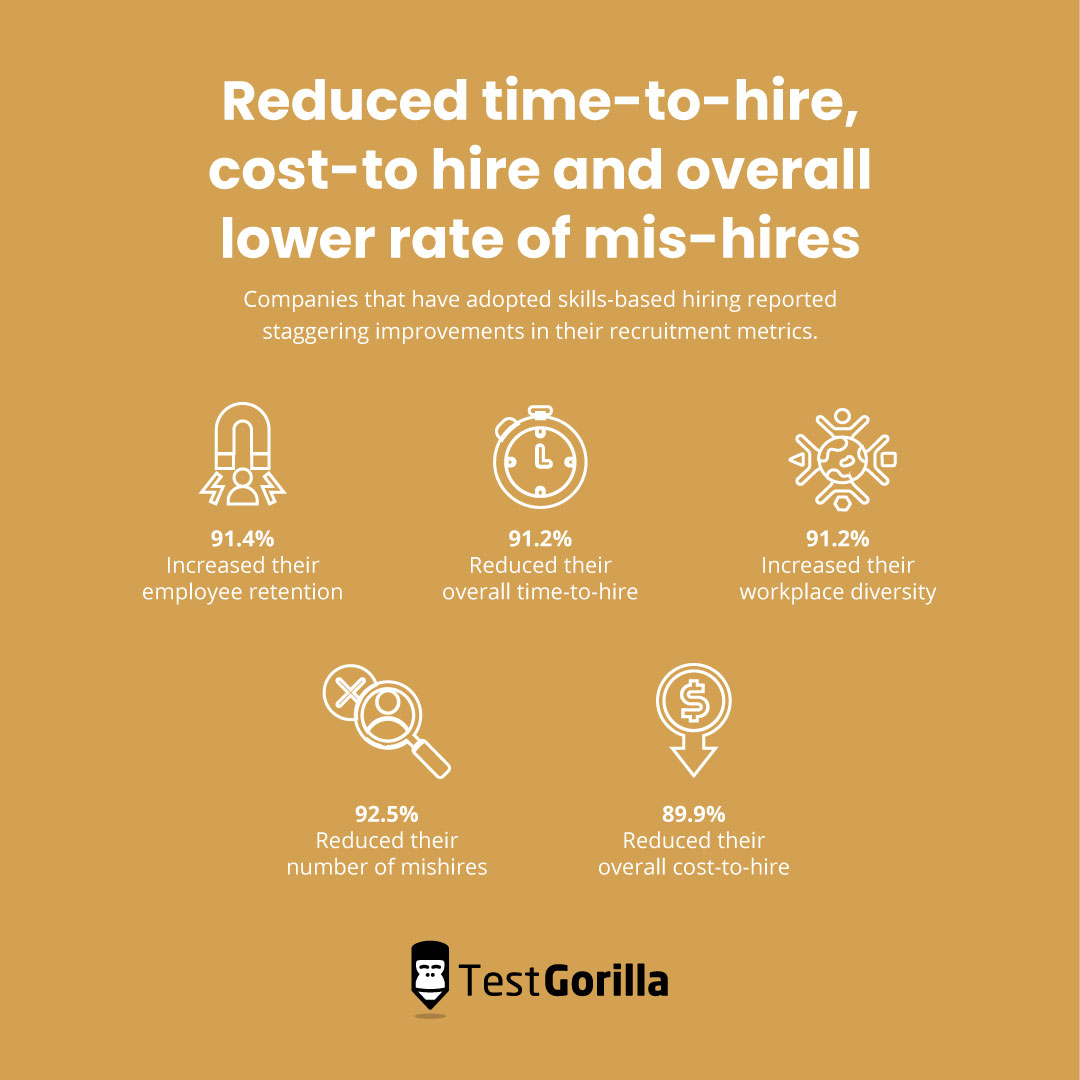Companies in all industries are engaged in a war for global talent. A war sparked by new opportunities caused by remote or hybrid working and growing disillusionment with traditional, biased hiring practices. All of which is causing casualties in terms of low employee retention and high rates of mis-hires.
This means HR teams across the globe are engaged in a daily battle to attract and retain top talent in the workplace. Also, they need to make sure employees are the right fit for their roles and manage them effectively once onboarded.
But it can be hard to outmaneuver competitors – and access talent with the right skill sets – when you’re competing on speed and responsiveness during hiring. Not to mention trying to understand a candidate’s potential and value-add from limited, two-dimensional resumes.
Skills-based hiring is your secret weapon to level the playing field. It helps you find the best people for the job, rather than focusing on connections, education, or previous experience.
We’ve put together a field map to help you understand the talent war and the implications for different industries, roles, and your company. In our armory, we’ve got new data from our 2022 State of Skills-Based Hiring report to help you understand why and how skills-based hiring can help you attract and retain world-class professionals.
Table of contents
What is the talent war?
The talent war is the ongoing battle companies engage in to attract, recruit, and retain the best global talent for their business and position.
In the tech world alone in 2021, 61% of HR managers agreed that finding qualified candidates was their biggest challenge, with 25% struggling to stand out from other companies.
Whether it’s a war for tech talent or any other kind of talent, it’s hard for HR teams and managers to get in front of the most suitable professionals and accurately evaluate their skills and value. Not to mention, outflank other companies on hiring responsiveness, speed, and transparency.
What are the costs of failing to attract and retain talent?
Failing to attract and retain the right warriors can cost you dearly in battle. By which we mean you lose your competitive edge and ability to grow and scale sustainably.
And hiring isn’t the only tactic you need to win the war. Not only is it potentially cheaper to retain, upskill, and promote talent internally, but there’s also the fallout from the impact of high employee turnover on organizational performance and team morale when you fail to retain talent.
When employees are falling around you like slain knights on the battlefield, it’s hard to maintain a stable company culture and ensure employee happiness and success. It’s also more challenging to stay competitive during hiring if you’re scrambling to find and interview suitable applicants and base assessments on a holistic understanding of each one.
Who is most at risk of losing the talent war?
Although businesses in a range of industries are struggling to find and retain the best talent after Covid-19, certain knowledge-based industries have been dealt a more severe blow.
For example:
Engineering
Software development
Manufacturing
Finance
Healthcare
Companies in all these industries are suffering from a short supply of skilled professionals. Since there’s a bigger demand for talent than workers, skilled job seekers are like swords-for-hire: at an advantage when searching for the right job and company. So if you’re in one of these industries, you need to do more to win over candidates.
6 strategies to win the talent war
To win the talent war, you need to differentiate your business from your competitors by aligning your hiring process with the skill sets you want to attract. It’s also vital to deeply understand the candidate’s value-add to your organization and ensure a fair and bias-free interview process.
This starts with adopting a talent-first mindset and using objective methods to make sure candidates have the right skills for the role before you start interviewing.
Let’s explore some ways you can do this.
1. Skills-based hiring
Skills-based hiring is your secret weapon in the talent war. It’s a new, more objective, and equitable recruitment approach that helps verify applicants’ skills in the early stages of hiring. It helps assess a candidate’s value-add to your organization through scientifically backed assessments that mirror on-the-job scenarios or feature skills-based tests.
Role-specific tests measure soft and hard skills like foreign-language ability and skills related to programming, communication, leadership, and much more. By contrast, tasks or assignments may involve asking candidates to submit a sample of work or complete a take-home project. This lets you assess their ability to handle role-specific situations.
Skills-based hiring lets you adopt a talent-first mindset that benefits your organization and employees by:
Promoting equality of opportunity, creating diverse teams, and widening the talent pool
Focusing on skill sets (hard and soft) over education, previous experience, or connections
Improving the quality of hires and job performance
Increasing organizational efficiency and reducing employee turnover
Freeing up HR and hiring managers to evaluate more assessments and candidates
Embracing the potential of modern technology with automated, anonymized testing
Also, by helping you assess and recruit the most appropriate and qualified candidates for each position, this method gives you more time to focus on optimizing your recruitment and onboarding experience. This reduces the number of steps an applicant needs to take throughout the hiring process, so they’re more likely to stay interested in your brand and offer.
“Nobody wants to put on a front or to be disingenuous when looking for a job, but they will be trying to fit this mold of what they think the job is. If you’re looking to actually match that person’s work style, and bring them in as they are, skills-based hiring can definitely help. It leads to better job satisfaction.”
Nicole Roberts, Senior vice-president of people, Forta.
Focusing on hiring the right employees using skills-based hiring can:
Reduce total time-to-hire, or how quickly you move a candidate through your hiring process: 91.4% of companies surveyed reduced their total time-to-hire through skills-based hiring.
Reduce total cost-to-hire, or the cost of each new employee: 89.8% of companies in our survey reduced the overall cost-to-hire with skills-based hiring.
Reduce total mis-hires, or assigning an unsuitable candidate to an open role: 92.7% of companies reduced the number of mis-hires.
All this gives you more financial and organizational flexibility – and the ability to gain a vital competitive advantage in the war for talent. And, of course, better attract skilled, top-tier professionals.
Skills-based hiring not only positively impacts the quality and consistency of your workforce, but it also encourages more candidates to apply – and stay – in their new roles.
After surveying 2,736 employers and 2,666 candidates for our report, The State of Skills-Based Hiring 2022, 54.3% of candidates agree they prefer a hiring process with skills-based assessments while 72.1% of candidates hired using skills-based testing report being happy in their role.
This is because skills-based hiring gives candidates a better idea of the requirements of the role they’re applying for. It also gives them the opportunity to see how well-suited they are for the role, and whether it aligns with their career objectives.
Meanwhile, it gives employers and hiring managers the ability to understand culture add in candidates and how motivated they are to join the company for better long-term alignment. Hiring for culture add, rather than culture fit, means new team members bring new skills, backgrounds, personalities, etc. to the table, which avoids creating homogenous teams.
Interestingly, our report shows that 69.3% of men hired using skills-based testing were happy in their current role, whereas 76.2% of women hired via skills-based hiring were happy. This means skills-based hiring can benefit women in the workplace by better aligning their skills and strengths with their ideal position.
2. Create a streamlined hiring process
The longer and more complicated the hiring process is for your business, the less likely it is for candidates to complete it and stay invested in your brand and position. Especially if they’re actively interviewing for other positions with faster turnaround.
To streamline your hiring process:
Use a pre-employment testing platform to accurately assess candidates and their credentials.
Utilize an Applicant Tracking Software (ATS) to centralize open positions and applicant information and generate actionable reports.
Administer skills-based hiring assessments to eliminate candidates who don’t have the right skills or approach.
It’s also important to be ultra-communicative and responsive with in-demand candidates during interview intervals and deliver rejections personally. A scheduling or communication slip-up can give your organization a bad reputation and deter other candidates from applying.
3. Prioritize continuous learning and development
As mentioned earlier, it’s often more cost-effective to train and retain your current employees than hire new ones. So, it’s important to provide talent with opportunities to advance their careers and expand their skills and make this known during the hiring process.
Conveying to new hires or candidates that your organization values their growth and upward mobility means they’ll want to stick around longer and can better envision themselves growing with, and staying loyal to, your brand.
Upskilling and reskilling employees can also:
Increase employee retention
Reduce recruitment costs when you fill positions internally
Boost employee morale
Help maintain a competitive edge in the face of growing automation and recession
Upskilling and reskilling can be as simple as a mentorship program or job shadowing higher-ups within the organization. But it can also involve:
Making development opportunities widely available
Investing in learning resources, webinars, or classes
Rewarding growth
Fostering a culture of curiosity
4. Showcase your company culture
To attract and retain top talent, you need to showcase an aligned company culture that accurately reflects your values. Especially considering nearly 70% of Americans value company culture and work benefits over salary.
One way you can do this is to use skills-based hiring to build up your company culture and attract better talent. Skills-based hiring contributes to a more cohesive company culture by:
Opening up the floor to diverse applicants from various backgrounds
Helping you find candidates for culture-add, not culture-fit
Reducing employee turnover by clearly outlining role and skill requirements—and responsibilities
Streamlining hiring and giving HR more employee-facing time for initiatives that boost company culture
5. Spotlight top performers
A-players want to work for top performers in any organization. So the better the talent you attract and recruit, the more top talent you’ll attract. It’s a positive feedback loop.
Spotlight top performers in your organization and their achievements across your company’s social media or LinkedIn, blog, website, and within company communication channels like Slack. This will help grow your network of interested candidates who want to work with the best.
Singling out the best performers becomes easy when you create a talent pipeline based on identifying people with the best skills over qualifications and experience.
Highlighting top talent on channels like LinkedIn can also turn your people into influencers or known figures in your niche or field to bolster your brand’s reputation and reach.
6. Offer perks and benefits
The perks and benefits you offer employees on your job description can make your organization stand out in a sea of job listings—and give you an opportunity to put into practice your core values.
But it’s not enough to provide the same benefits other employers or organizations offer in your industry. Instead, try to think of unique perks that align with your particular sector.
For example, if you’re hiring for your health food brand, you might offer your employees free healthy lunches or a gym membership stipend. If you’re in education, offer courses and certifications that will help you and your employees stay relevant.
Some examples of on-brand and unique perks you might offer candidates and employees include:
Remote or hybrid working opportunities
Pet-friendly work environments
Unlimited paid time off
Allowances for travel, home-working, and further education
Free snacks and drinks
On-site gym or gym membership
Skills-based hiring: Your secret weapon to win the talent war
In the ongoing talent war, it’s hard for HR teams to attract the right warriors (aka skilled professionals). Also, to understand a candidate’s value-add to your organization, and locate the right skill sets, all while battling competitors for visibility.
But the quality of the talent you attract and retain reflects the quality of your hiring processes—and your ability to remain competitive. So you can’t afford to let them go rusty or fall behind.
Strategies to win the talent war include:
Applying skills-based hiring to find the right candidates for each role
Creating a streamlined hiring process
Prioritizing continuous learning and discovery
Showcasing your company culture
Spotlighting top performers
Offering industry-relevant perks and benefits
Of all these, skills-based hiring is your most powerful weapon as it serves as the basis for the rest. Once armed, it lets you streamline your hiring process and level the playing field for diverse candidates. So you can choose the right person for each role based on what they bring to it, rather than qualifications or experience.
By focusing on skills, you improve the quality of your hires, increase efficiency and performance, and promote equality of opportunity. This results in happier, more diverse, and more effective teams and a company culture that prioritizes learning. Not to mention top performers you can be proud of. All of which has a positive knock-on effect on your ability to attract and retain top-tier talent.
Want to win the talent war?
Skills-based hiring is your secret weapon to improve hiring ROI and access top talent. Download the State of Skills-based Hiring report to learn more.
Related posts
Hire the best candidates with TestGorilla
Create pre-employment assessments in minutes to screen candidates, save time, and hire the best talent.
Latest posts
The best advice in pre-employment testing, in your inbox.
No spam. Unsubscribe at any time.

Hire the best. No bias. No stress.
Our screening tests identify the best candidates and make your hiring decisions faster, easier, and bias-free.
Free resources
This checklist covers key features you should look for when choosing a skills testing platform
This resource will help you develop an onboarding checklist for new hires.
How to assess your candidates' attention to detail.
Learn how to get human resources certified through HRCI or SHRM.
Learn how you can improve the level of talent at your company.
Learn how CapitalT reduced hiring bias with online skills assessments.
Learn how to make the resume process more efficient and more effective.
Improve your hiring strategy with these 7 critical recruitment metrics.
Learn how Sukhi decreased time spent reviewing resumes by 83%!
Hire more efficiently with these hacks that 99% of recruiters aren't using.
Make a business case for diversity and inclusion initiatives with this data.

























